What's in the box this week~~~~~~~~~~~~~~~~~~~~~~~~~~~~~~~~~~~~~~~~~~~~~~~~
Content differences between Family and
Small shares are in red; items with a
"+" in one size share are more in quantity than in the other. For any items
not from our farm, we will identify the source in parentheses. Occasionally content will differ
from this list (typically we make a substitution), but we do our best to
give you an accurate projection.
Family Share
Arugula
Basil
Napa cabbage
Carrots
Cilantro
Kale
Lettuce +
Bunching onions
Pickling cucumbers or Summer squash
Red potatoes
Radicchio
Radishes
Spinach
Strawberries
Small Share
Arugula
Basil
Broccoli
Carrots
Cilantro
Lettuce
Bunching onions
Radicchio
Radishes
Spinach
Strawberries
Bread Option
This week's bread will be caraway rye
Extra Fruit
3 baskets of strawberries
1 basket of raspberries or blackberries
1 bag of plums (Santa Rosa) and apricots (Blenheim)
Fruit Bounty is 'on' this week (floating week #9 of 15)
5 baskets of Strawberries
|
Summer flavors need Summer Patience
~~~~~~~~~~~~~~~~~~~~~~~~~~~~~~~~~~~~~~~~~~~~~~~~ Officially we are two weeks into Summer and I am like most of you, a bit restless, waiting to finally bite into a red ripe dry-farmed tomato. Farming and eating with the seasons is of course not an exact science; the ripeness and flavors of summer fruit and vegetables adhere more to the loose schedule of mother nature's rhythms rather than to a date on a calendar. The cooler growing climate here on the farm may have its advantages -- like allowing us to grow a larger diversity of both cool and heat loving crops side by side such as broccoli next to melons, arugula and spinach next to peppers and tomatoes -- but it also asks us to have patience during the early part of summer. (Yesterday for our
4th of July BBQ, for example, my wife Constance bought tomatoes to put on the
hamburgers... and I felt a bit disappointed that they weren't ours.) Our early-summer patience pays off though: typically we are rewarded with a long frost-free growing season into late fall, so we often still have peppers, tomatoes, and green beans into early November.
This morning I took the camera along on my field walks so as to give you a snapshot of the different summer crops currently growing in the field, and their various stages of maturity and ripeness (see below). We'll start
harvesting pickling cucumbers and green beans in bountiful amounts beginning next week. You will notice cucumbers already in some of the shares this week. With any luck (i.e. warmer weather), the first tomatoes will be in your shares in 10-14 days. Sweet peppers should begin appearing by the end of the month, and eggplants probably not until early August. Tomatillos are on the same schedule as the tomatoes, and I am confident the canteloupe will show up in fruit shares by early August. We have planted several successions of tomatoes and peppers, so as to last us well into October.
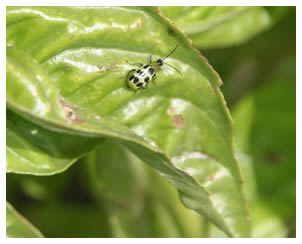 Although a bit chewed up by cucumber beetles (see picture), basil should also be plentiful for the remainder of the season. It may not look so attractive if used as whole leaves on fresh slices of mozarella, but chopped up in sauces or made into pesto it should be just fine. Next week we will be digging my favorite: fingerling potatoes, and more dill is also on the way. Although a bit chewed up by cucumber beetles (see picture), basil should also be plentiful for the remainder of the season. It may not look so attractive if used as whole leaves on fresh slices of mozarella, but chopped up in sauces or made into pesto it should be just fine. Next week we will be digging my favorite: fingerling potatoes, and more dill is also on the way.
Eating with the seasons is not only a way to understand the rhythm of the crop cycles but also their growing practices, the challenges that go along with them and the imperfections which at times don't jive with the picture perfect aesthetics we are often accustomed to see in advertising or in supermarkets. Ultimately eating what is grown directly on a local farm is a way to go beyond the grocery store and experience how your food is produced. If we see farms as an opportunity to establish a relationship with the people who grow our food, we can, I am convinced, directly improve the vitality of the place we live in, our personal health and that of our community.
- Tom
|
Pictures from the field walk
~~~~~~~~~~~~~~~~~~~~~~~~~~~~~~~~~~~~~~~~~~~~~~~~ 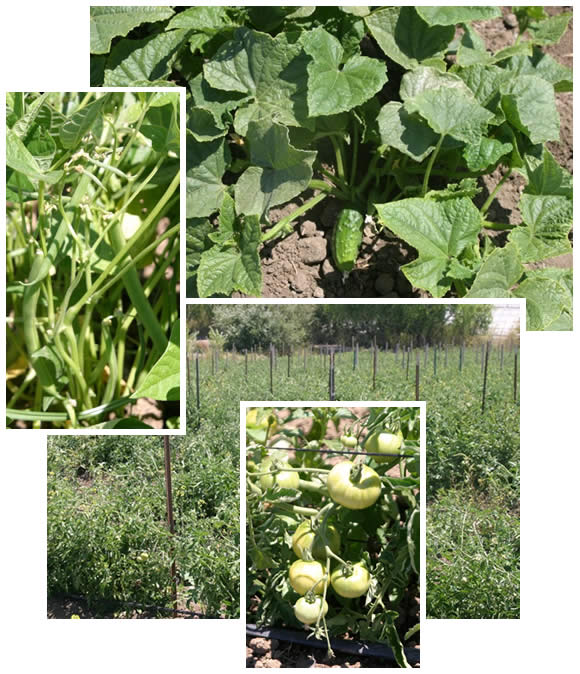 Above: a pickling cucumber, green beans, staked tomato plants, and tomatoes just starting to ripen. Below: an eggplant blossom and field of eggplant, and tomatillos. 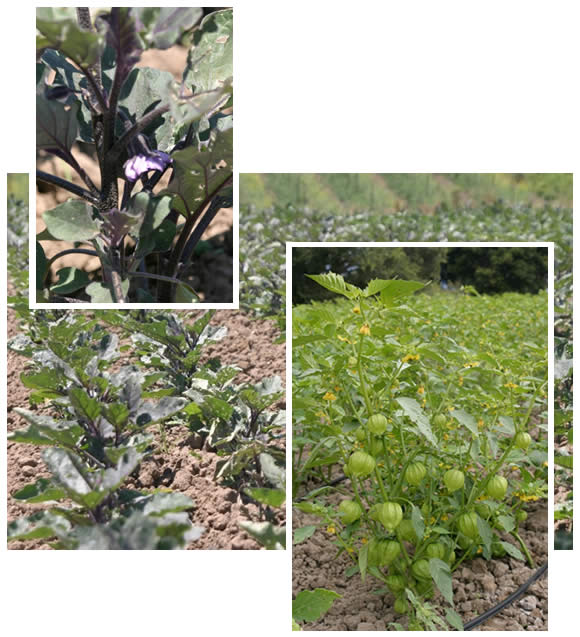 Below: a cantaloupe patch and ripening melon, and a field and closeup of sweet peppers. 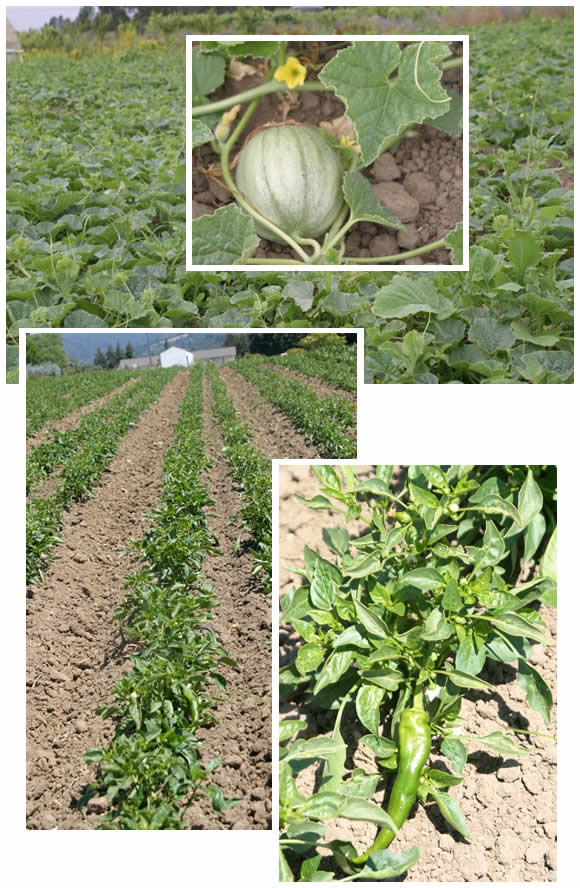 |
Farming and Cooking Staples: Collards, Chard, and Kale
~~~~~~~~~~~~~~~~~~~~~~~~~~~~~~~~~~~~~~~~~~~~~~~~  We grow these three cooking greens almost year-round, and it's probably my wife Constance, a "greens addict", who makes sure we are never without them. I am sure most of us typically don't rank greens very high on our "most favorite veggie" list, but based on my personal experience it doesn't take much to really like them. I don't get turned onto a vegetable if the argument in its favor is just nutritional, reduced to a bunch of vitamins and minerals. Kale, Chard and Collards, although nutritional super stars, have both life and a certain personality. Next time you take a bunch out of your share look closely at the amazing rich green colors, the texture and finely woven pattern of "veins" running over the entire leaf surface down into the stem. Their distinct flavors and textures make them amazingly versatile, and Debbie's recipes probably make the most convincing case for them. They are all interchangeable with other veggies, like kale for broccoli, and they can be cooked in so many different ways, whether chopped and sauteed, with a pinch of salt, olive oil, onions and garlic (my personal favorite and most common cooking method), blanched, with butter or cream, in soups or pasta, rice, beans, and potatoes. Also in quesadillas, crepes, lasagna and macaroni and cheese. For breakfast in scrambled eggs, in quiche, or omelettes. They round out almost any meal, as a side dish or cooked with a main dish. I hope -- especially members who are getting shares for the first time -- you will give these "uninteresting looking bunches" a second chance! - Tom |
Notes from Debbie's Kitchen~~~~~~~~~~~~~~~~~~~~~~~~~~~~~~~~~~~~~~~~~~~~~~~~ Click here to go to the recipe database.Aaah, the anticipation of summer bounty (tomatoes, peppers, eggplant, green beans) is sweet... I can almost taste the tomatoes! Looks like it won't be too much longer now. In the meantime, here are a few ideas for using what's in this week's box -- hooray for the return of radicchio, three cheers for spinach, and yay for arugula! (I always love getting arugula... and potatoes and kale and lettuce and carrots and... well, I pretty much like everything!) - Debbie
. . . . . . . . . . . . . . .
Let's start with strawberries. Still looking for ways to use your bounty of strawberries? Here's a nice twist on your glass of breakfast orange juice:
Strawberry OJ
Instead of just pouring yourself a glass of orange juice in the morning, consider taking a few extra minutes and making it into strawberry orange juice! Just wash, hull and halve or quarter a bunch of strawberries into a blender, add orange juice and blend! You can thin it out a little with water and it is still plenty rich and fruity. Proportions are not critical; this morning, I used a basket of strawberries and juice from one large orange, and probably thinned it with about a third of a cup of water. Made two 8-oz glasses of yummy juice! Very strawberry-y. ;-) Radishes in Potato SaladJust wanted to reiterate for the radish-phobic out there that they add great color and crunch, plus a little peppery bite to potato salad! So think twice before putting radishes into the trades box... I can already taste a potato salad made with radishes and arugula... mmmm! Remember the secret from last week: toss cooked cut-up potatoes with vinegar or vinaigrette while the potatoes are still warm, then fold in vegetables, then add additional dressing to taste. Debbie's pan-browned radicchioI know I repeat myself on this one, but it really is my favorite way to prepare radicchio!
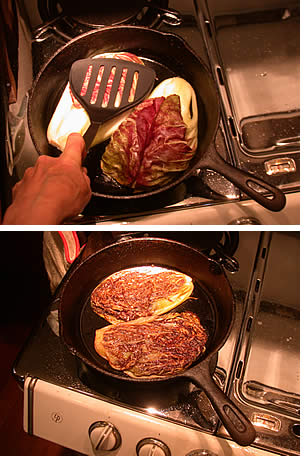 Take the head of radicchio, quarter it,
leaving the stem intact to hold the quarters together.
[Pictures
at left used an oblong variant of radicchio, so I
just
halved it instead of quartering it, but the principle is the
same.] Sprinkle quarters with salt: with one hand, kind of fan each quarter out a bit, so that
when you
sprinkle the salt, it gets down in-between the
leaves as
well as on the outside. The best skillet to use is cast
iron, but
if you don't have one, use what you have. Heat oil in the
skillet
over medium heat, then lay the quarters in their sides,
stems to
the middle (fanned out pinwheel style). Using a spatula,
press down
on them, to encourage them to flatten out. Reduce heat to
medium-low
or so, cover and cook for a maybe 5 minutes, going in every
so often
to press down on them again with the spatula. They will
start to
turn brown (this is good). You don't want them to burn, but
you do
want them to get well browned and fully wilted. When they
seem to
be softening up well and flattening easier, carefully flip
them over
so they can brown on the other side, maybe another 5 minutes
or so.
Continue pressing down on them periodically. When they are
done (they
should be brown through-and-through and nice and soft),
drizzle a
little balsamic vinegar over them, down in-between the
leaves, and
cook another minute or so. Take the head of radicchio, quarter it,
leaving the stem intact to hold the quarters together.
[Pictures
at left used an oblong variant of radicchio, so I
just
halved it instead of quartering it, but the principle is the
same.] Sprinkle quarters with salt: with one hand, kind of fan each quarter out a bit, so that
when you
sprinkle the salt, it gets down in-between the
leaves as
well as on the outside. The best skillet to use is cast
iron, but
if you don't have one, use what you have. Heat oil in the
skillet
over medium heat, then lay the quarters in their sides,
stems to
the middle (fanned out pinwheel style). Using a spatula,
press down
on them, to encourage them to flatten out. Reduce heat to
medium-low
or so, cover and cook for a maybe 5 minutes, going in every
so often
to press down on them again with the spatula. They will
start to
turn brown (this is good). You don't want them to burn, but
you do
want them to get well browned and fully wilted. When they
seem to
be softening up well and flattening easier, carefully flip
them over
so they can brown on the other side, maybe another 5 minutes
or so.
Continue pressing down on them periodically. When they are
done (they
should be brown through-and-through and nice and soft),
drizzle a
little balsamic vinegar over them, down in-between the
leaves, and
cook another minute or so.
You can serve them just
like this and they are delicious, but if you want to go one step
further, slice up some mozarella cheese and lay it on top of the
radicchio, cover and heat until melted, then serve. Or if you have the
wherewithal (and an oven-proof skillet), slip the pan under a broiler,
or into a very hot oven, so that the cheese not only melts, but browns a
little bit, like the top of a pizza!Pan-browned radicchio on pizza!If you ever make your own pizza (I do this a lot - go here for my pizza dough recipe), coarsely chopping up the pan-browned radicchio and adding it as a pizza topping is major-yummo! Pizzas are a great way to eat a lot of things. You could make pesto with the basil, then spread that on your crust, then top it with chopped pan-browned radicchio... scatter some cubes of good mozzarella on top to bubble and brown in the oven... mmmm! Speaking of basil, here's a recipe in the database worth repeating. I find it so very interesting, because it uses an herb normally considered savory in a sweet cookie; yummy, if you haven't tried it yet:Lemon and Basil
shortbread
from March 2006
sunset magazine, modified
1 C butter, room
temperature
1/2 C sugar
1 tsp. grated lemon
peel
1 tbsp. lemon juice
2 1/2 C flour
6 tbsp. cornstarch
1 tbsp. minced fresh
basil leaves
Preheat oven to 300
degrees.
In a food processor, whirl all ingredients until smooth.
Press dough
into two 8-inch cake pans with removable rims [or just pat
the dough
out into two evenly thick circles a cookie sheet like I do; I
don't have the fancy pans]. Pierce dough all over
with the tines of a fork, and (optionally) press tines of fork
gently
all around the perimeter to make a pattern. Bake until firm to
the touch
and slightly browned, about 45 minutes. Sprinkle hot rounds
with 1 tbsp.
sugar each [I'd say this is optional too], remove pan rims, if
using, and while still warm, cut each circle into
wedges [you
won't be able to do this once they've cooled!]. Cool
completely
while still on pan bottoms (or cookie sheets) set on a rack,
then separate
wedges and serve or store airtight up to 1 week.
And here's a good one for the cabbage and carrots! Particularly good when we have cilantro at the same time...Cabbage-carrot stir-fry burritosonion and/or garlic shredded cabbage (either Napa or regular is fine) grated carrot egg soy sauce hoisin sauce ginger (either a little minced fresh ginger root, or a little ground dried) flour tortillas chopped fresh cilantro coarsely chopped cashews (optional) In a hot skillet or wok, cook chopped onion and/or garlic (and ginger, if using fresh) until starts to soften; add cabbage and carrot and stir-fry until cabbage wilts and maybe just begins to brown (you can add dry ginger in this step, if using); add a slightly-beaten egg (or you can just crack the egg into the pan and mix it a little right there) and stir to mix and coat veggies; it will cook quickly, and this is fine. Lastly, season with a little soy sauce and hoisin sauce. Stir to mix and heat until bubbly, then serve like 'wraps' in warm flour tortillas, adding a generous handful of chopped cilantro and some chopped cashews to each before rolling up. Serve with optional hot sauce of your liking. Lastly, back to potatoes; here is a recipe for potato samosas by a famous Indian Cooking writer, Madhur Jaffrey. There are many variations on samosa dough and filling, but I trust Madhur Jaffrey. She's been adapting Indian recipes for the non-Indian cook for a long time.Madhur Jaffrey's Potato SamosasFor the pastry: 2 C flour 1/2 tsp. salt 4 tbsp. oil 4 tbsp. water For the filling: 4-5 medium potatoes, boiled in their jackets and allowed to cool 4 tbsp. oil 1 medium onion, peeled and finely chopped [or chop up the bunching onions] 1 C shelled peas [frozen is fine; we don't have fresh peas right now] 1 tbsp. finely grated peeled fresh ginger 1 fresh hot green chili, finely chopped 3 tbsp. very finely chopped cilantro 3 tbsp. water 1 1/2 tsp. salt 1 tsp. ground coriander seeds 1 tsp. garam masala 1 tsp. ground roasted cumin seeds 1/4 tsp. cayenne pepper 2 tbsp. lemon juice oil for deep frying To make the pastry: Sift the flour and salt into a bowl. Add the 4 tablespoons of oil and rub it in with your fingers until the mixture resembles coarse breadcrumbs. Slowly add about 4 tablespoons water -- or a tiny bit more -- and gather the dough into a stiff ball. Empty the ball out on to clean work surface. Knead the dough for about 10 minutes or until it is smooth. Make a ball. Rub the ball with about 1/4 teaspoon oil and slip it into a plastic bag. Set aside for 30 minutes or longer. To make the filling: Peel the potatoes and cut them into 1/4 inch dice and set aside. Heat 4 tablespoons oil in a large frying pan over a medium flame. When hot, put in the onion. Stir and fry until brown at the edges. Add the peas, ginger, green chili, cilantro, and 3 tablespoons water. Cover, lower heat and simmer until peas are cooked. Stir every now and then and add a little more water if the frying pan seems to dry out. Add the diced potatoes, salt, coriander seeds, garam masala, roasted cumin, cayenne, and lemon juice. Stir to mix. Cook on low heat for 3-4 minutes, stirring gently as you do so. Check balance of salt and lemon juice. You may want more of both. Turn off the heat and allow the mixture to cool. Knead the pastry dough again and divide it into eight balls. Keep 7 covered while you work with the eighth. Roll this ball out into a 7 inch (18 cm) round. Cut it in half with a sharp, pointed knife. Pick up one half and form a cone, making a 1/4 inch wide (5 mm), overlapping seam. Glue this seam together with a little water. Fill the cone with about 2 1/2 tablespoons of the potato mixture. Close the top of the cone by sticking the open edges together with a little water. Again, your seam should be about 1/4 inch (5 mm) wide. Press the top seam down with the prongs of a fork or flute it with your fingers. Make 7 more samosas. Heat about 1 1/2 to 2 inches (4-5 cm) of oil for deep frying over a medium-low flame. You may use a small, deep, frying pan for this or an Indian karhai. When the oil is medium hot, put in as many samosas as the pan will hold in a single layer. Fry slowly, turning the samosas frequently until they are golden brown and crisp. Drain on paper towels and serve hot, warm, or at room temperature. |
|
2010 CALENDAR
~~~~~~~~~~~~~~~~~~~~~~~~~~~~~~~~~~~~~~~~~~~~~~~~
Visit our website's calendar page for more details, including photos and videos of past events. This is a great way to get the flavor of what it is like visiting the farm!
Live Earth Farm Discovery Program for WEE ONES
3rd Tuesday of every month, 10:30am - Noon
(free for children 0 - 3 yrs; $10 - $15 per adult)
 Mothers, fathers, grandparents, caretakers of any kind... bring the babe in your arms to experience the diversity of our beautiful organic farm here in Watsonville. We will use our five senses to get to know the natural world around us. The farm is home to over 50 different fruits and vegetables, chicks, chickens, goats, piglets, and the many wild members of the Pajaro watershed. Mothers, fathers, grandparents, caretakers of any kind... bring the babe in your arms to experience the diversity of our beautiful organic farm here in Watsonville. We will use our five senses to get to know the natural world around us. The farm is home to over 50 different fruits and vegetables, chicks, chickens, goats, piglets, and the many wild members of the Pajaro watershed.
For more information, contact Jessica at the LEFDP office: (831) 728-2032 or email her at lefeducation@baymoon.com.

Happy Girl Kitchen's 2010 Workshop Schedule at LEF
(all workshops are from 10am to 3pm and include an organic lunch, as well as take-home items from what is made that day!)
March 6 (Saturday) - Fermentation (sauerkraut, kimchee and kombucha)
April 10 (Saturday) - Cheese and kefir
June 6 (Sunday) - Cherries and Spring Berries
July 10 (Saturday) - Apricots, strawberries and blackberries
September 12 (Sunday) - Heirloom tomatoes
October 2 (Saturday) - Pickles
Contact Jordan if you have any questions
jordan@happygirlkitchen.com
http://www.happygirlkitchen.com
Art on the Farm Summer Day Camp!
July 12th - 16th
click here for more information
Community Farm Days Schedule
(All Community Farm Days are Saturdays unless otherwise noted.)
March 20 - Sheep to Shawl
May 29 - Three sisters planting in the field! Help sow pumpkins, corn, and beans (update 5/24: see Event Schedule in Week 9 newsletter)
June 19 - Summer Solstice Celebration and Strawberry U-pick
July 3 - Apricot and Strawberry U-pick CANCELLED.
July 12 thru 16 - Summer Celebration Art on the Farm Day Camp!
Aug 28 - Totally tomatoes. From farm to fork, cooking with tomatoes and making farm-fresh cheese. Also U-pick raspberry and tomato day!
Sept 25 - LEFDP Second Annual Fundraiser
Oct 23 - Harvest Celebration and Apple U-pick
|
|